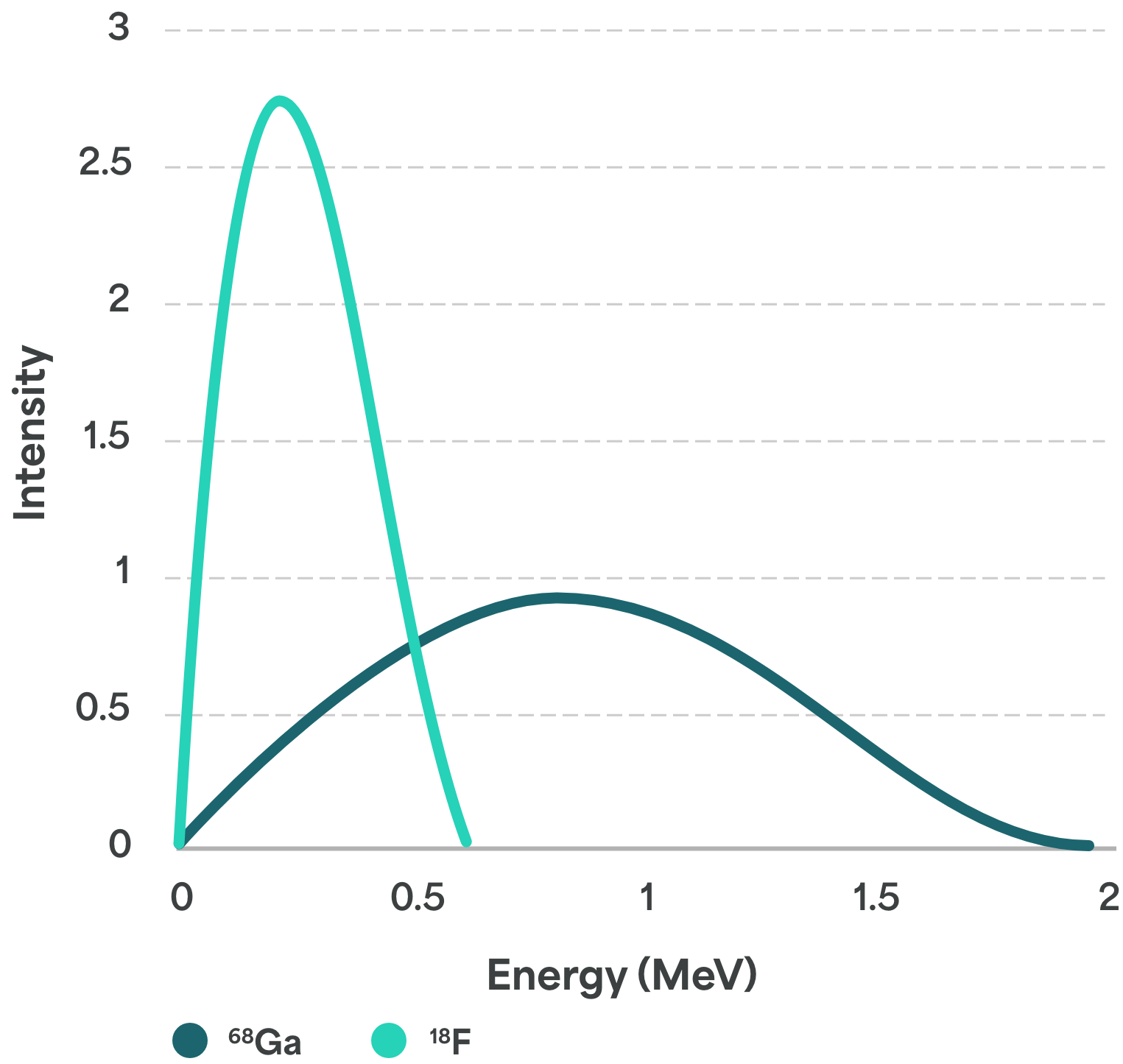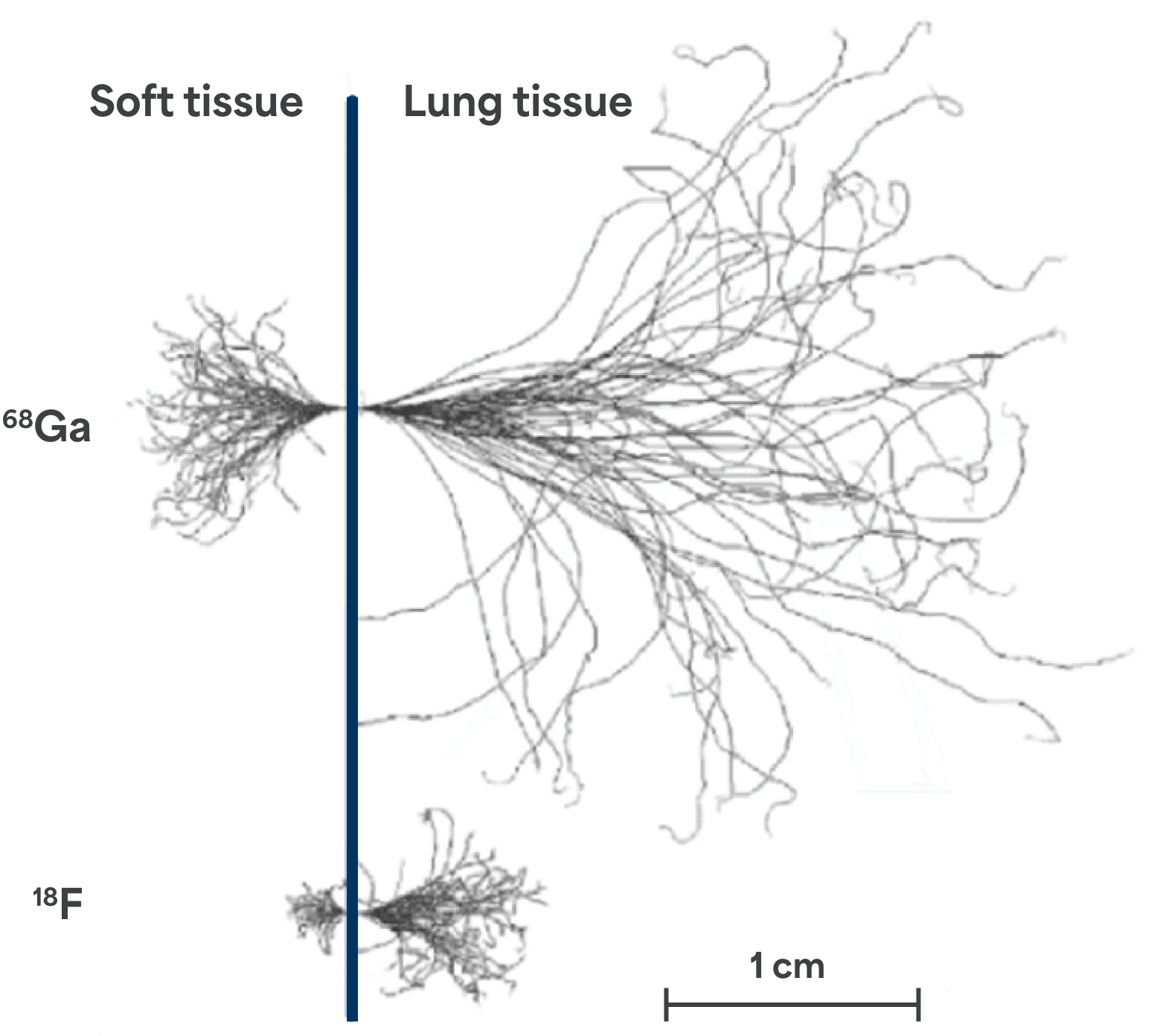PYLARIFY PET/CT combines the accuracy of PET imaging, the precision of PSMA targeting, and the clarity of an 18F radioisotope1-8
PYLARIFY® (piflufolastat F 18) injection is indicated for positron emission tomography (PET) of prostate-specific membrane antigen (PSMA) positive lesions in men with prostate cancer:
- with suspected metastasis who are candidates for initial definitive therapy
- with suspected recurrence based on elevated serum prostate-specific antigen (PSA) level
Piflufolastat F 18 Injection (PYLARIFY) is
National Comprehensive Cancer Network®
(NCCN®) Recommended (Category 2A*)9
NCCN recommends piflufolastat F 18 Injection (PYLARIFY) as an alternative to standard imaging of bone and soft tissue for:
- Initial risk stratification for certain patients with localized PCa
- Detection of BCR disease after radical prostatectomy (preferred to conventional imaging)
- Detection of BCR disease after radiation therapy (preferred to conventional imaging)
- As workup for progression
Although the FDA has approved Ga-68 PSMA-11 for use with Lu-177–PSMA-617, the panel believes that F-18 piflufolastat PSMA and F-18 flotufolastat PSMA can also be used in the same space due to multiple reports describing the equivalency of these imaging agents.
Because of the increased sensitivity and specificity of PSMA-PET tracers for detecting micrometastatic disease compared to conventional imaging (CT, MRI) at both initial staging and biochemical recurrence, the [NCCN] Panel does not feel that conventional imaging is a necessary prerequisite to PSMA-PET and that PSMA-PET/CT or PSMA-PET/MRI can serve as an equally effective, if not more effective front-line imaging tool for these patients.
NCCN is generally consistent with SNMMI Appropriate Use Criteria
According to SNMMI Criteria, piflufolastat 18F (PYLARIFY) is appropriate for10:
- Men with newly diagnosed unfavorable intermediate-, high-, or very-high-risk PCa
- Men with BCR after radical prostatectomy or radiation therapy
- Men with CRPC shown to be M0 on standard imaging
- Evaluation of eligibility for patients being considered for PSMA-targeted radioligand therapy
NCCN=National Comprehensive Cancer Network® (NCCN®)
*Category 2A recommendations are made when based upon lower-level evidence there is uniform NCCN consensus that the intervention is appropriate.
NCCN makes no warranties of any kind whatsoever regarding their content, use or application and disclaims any responsibility for their application or use in any way.
Targeting PSMA enables PYLARIFY PET/CT to improve disease assessment in prostate cancer—even when PSA levels are low11,12†

PSMA is a validated molecular target for PCa; it is overexpressed in >90% of tumor cells6

PSMA levels have a high prognostic value; higher PSMA expression is associated with higher Gleason score and lower survival rates13
†PSA <2 ng/mL.
PYLARIFY is an 18F-labeled diagnostic imaging agent for PET that targets PSMA14
PYLARIFY uses 18F to bring greater clarity and convenience to PET/CT imaging2,7,15
As demonstrated in a head-to-head analysis, PET with 18F provides superior clarity compared to 68Ga because of the lower endpoint positron energy emission, which results in a shorter distance traveled by positrons prior to annihilation.15
Positron energy spectrum for the decay of 68Ga and 18F

Monte Carlo simulation of different positron tracks from the decay of 68Ga and 18F in human lung and soft tissues

- PET/CT with 18F has higher sensitivity and better resolution than PET/CT with 68Ga, potentially facilitating more accurate interpretation and reporting of disease assessment15
- 18F has a longer half-life than 68Ga (110 minutes versus 68 minutes), allowing for more widespread availability as well as more convenient and flexible scheduling for patients and staff2,16
See efficacy data in patients with high-risk PCa who were candidates for initial definitive therapy

18F=radioisotope fluorine-18; 68Ga=radioisotope gallium-68; BCR=biochemically recurrent disease; CRPC=castration-resistant prostate cancer; CT=computed tomography; MRI=magnetic resonance imaging; NCCN=National Comprehensive Cancer Network; PCa=prostate cancer; PET=positron emission tomography; PSMA=prostate-specific membrane antigen; SNMMI=Society of Nuclear Medicine and Molecular Imaging.
INDICATION & IMPORTANT
SAFETY INFORMATION
PYLARIFY (piflufolastat F 18) Injection is a radioactive diagnostic agent indicated for positron emission tomography (PET) of prostate-specific membrane antigen (PSMA) positive lesions in men with prostate cancer:
- with suspected metastasis who are candidates for initial definitive therapy.
- with suspected recurrence based on elevated serum prostate-specific antigen (PSA) level.
Radiation Risks
Diagnostic radiopharmaceuticals, including PYLARIFY, expose patients to radiation. Radiation exposure is associated with a dose-dependent increased risk of cancer. Ensure safe handling and preparation procedures to protect patients and health care workers from unintentional radiation exposure. Advise patients to hydrate before and after administration and to void frequently after administration.
INDICATION
PYLARIFY® (piflufolastat F 18) Injection is a radioactive diagnostic agent indicated for positron emission tomography (PET) of prostate-specific membrane antigen (PSMA) positive lesions in men with prostate cancer:
- with suspected metastasis who are candidates for initial definitive therapy.
- with suspected recurrence based on elevated serum prostate-specific antigen (PSA) level.
References
- Mena E, Lindenberg ML, Turkbey IB, et al. 18F-DCFPYL PET/CT imaging in patients with biochemically recurrent prostate cancer after primary local therapy. J Nucl Med. 2020;61(6):881-889. doi:10.2967/jnumed.119.234799
- Werner RA, Derlin T, Lapa C, et al. 18F-labeled, PSMA-targeted radiotracers: leveraging the advantages of radiofluorination for prostate cancer molecular imaging. Theranostics. 2020;10(1):1-16. doi:10.7150/thno.37894
- Alipour R, Azad A, Hofman MS. Guiding management of therapy in prostate cancer: time to switch from conventional imaging to PSMA PET? Ther Adv Med Oncol. 2019;11:1-14. doi:10.1177/1758835919876828
- Petersen LJ, Zacho HD. PSMA PET for primary lymph node staging of intermediate and high-risk prostate cancer: an expedited systematic review. Cancer Imaging. 2020;20(1):1-8. doi:10.1186/s40644-020-0290-9
- Tan N, Oyoyo U, Bavadian N, et al. PSMA-targeted radiotracers versus 18F fluciclovine for the detection of prostate cancer biochemical recurrence after definitive therapy: a systematic review and meta-analysis. Radiology. 2020;296:44-55. doi:10.1148/radiol.2020191689
- Ceci F, Fanti S. PSMA PET/CT imaging in prostate cancer: why and when. Clin Transl Imaging. 2019;7:377-379. doi:10.1007/s40336-019-00348-x
- Dietlein M, Kobe C, Kuhnert G, et al. Comparison of [18F]DCFPYL and [68Ga]Ga-PSMA-HBED-CC for PSMA-PET imaging in patients with relapsed prostate cancer. Mol Imaging Biol. 2015;17(4):575-584. doi:10.1007/s11307-015-0866-0
- Szabo Z, Mena E, Rowe SP, et al. Initial evaluation of [18F]DCFPYL for prostate-specific membrane antigen (PSMA)-targeted PET imaging of prostate cancer. Mol Imaging Biol. 2015;17(4):565-574. doi:10.1007/s11307-015-0850-8
- Referenced with permission from the NCCN Clinical Practice Guidelines in Oncology (NCCN Guidelines®) for Prostate Cancer. V.3.2024. © National Comprehensive Cancer Network, Inc. 2024. All rights reserved. Accessed April 1, 2024. To view the most recent and complete version of the guidelines, go online to NCCN.org. NCCN makes no warranties of any kind whatsoever regarding their content, use or application and disclaims any responsibility for their application or use in any way.
- Appropriate use criteria for prostate-specific membrane antigen (PSMA) PET imaging. Society of Nuclear Medicine & Molecular Imaging. Updated March 2022. Accessed June 1, 2022. https://www.snmmi.org/ClinicalPractice/content.aspx?ItemNumber=38657.
- Pienta KJ, Gorin MA, Rowe SP, et al. A phase 2/3 prospective multicenter study of the diagnostic accuracy of prostate-specific membrane antigen PET/CT with 18F-DCFPyL in prostate cancer patients (OSPREY). J Urol. 2021;206(1):52-61. doi:10.1097/JU.0000000000001698
- Morris MJ, Rowe SP, Gorin MA, et al. Diagnostic performance of 18F-DCFPyL-PET/CT in men with biochemically recurrent prostate cancer: results from the CONDOR phase III, multicenter study. Clin Cancer Res. 2021;27(13):3674-3682. doi:10.1158/1078-0432.CCR-20-4573
- Hupe MC, Philippi C, Roth D, et al. Expression of prostate-specific membrane antigen (PSMA) on biopsies is an independent risk stratifier of prostate cancer patients at time of initial diagnosis. Front Oncol. 2018;8:623. doi:10.3389/fonc.2018.00623
- PYLARIFY [package insert]. North Billerica, MA: Progenics Pharmaceuticals, Inc., a Lantheus company.
- Sanchez-Crespo A. Comparison of Gallium-68 and Fluorine-18 imaging characteristics in positron emission tomography. Appl Radiat Isot. 2013;76:55-62. doi:10.1016/j.apradiso.2012.06.034
- Martiniova L, Palatis L, Etchebehere E, Ravizzini G. Gallium-68 in medical imaging. Curr Radiopharm. 2016;9(3):187-207. doi:10.2174/1874471009666161028150654
